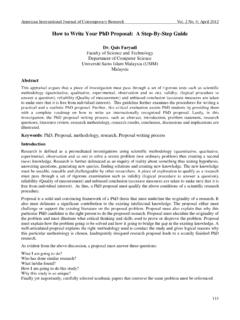Transcription of Articles Reduction in overdose mortality after the …
1 Published online April 18, 2011 (10)62353-7 1 Published Online April 18, 2011 (10)62353-7 See Online/Comment (11)60132-3 British Columbia Centre for Excellence in HIV/AIDS (B D L Marshall PhD, M-J Milloy MSc, E Wood PhD, Prof J S G Montaner MD, T Kerr PhD), Faculty of Medicine (E Wood, J S G Montaner, T Kerr), School of Population and Public Health, University of British Columbia (M-J Milloy), Vancouver, BC, Canada; and Department of Epidemiology, Mailman School of Public Health, Columbia University, New York, NY, USA (B D L Marshall)Correspondence to Thomas Kerr, Urban Health Research Initiative, BC Centre for Excellence in HIV/AIDS, St Paul s Hospital, 608 1081 Burrard Street, Vancouver, BC, Canada, V6Z 1Y6 in overdose mortality after the opening of North America s first medically supervised safer injecting facility.
2 A retrospective population-based studyBrandon D L Marshall, M-J Milloy, Evan Wood, Julio S G Montaner, Thomas KerrSummaryBackground overdose from illicit drugs is a leading cause of premature mortality in North America. Internationally, more than 65 supervised injecting facilities (SIFs), where drug users can inject pre-obtained illicit drugs, have been opened as part of various strategies to reduce the harms associated with drug use. We sought to determine whether the opening of an SIF in Vancouver, BC, Canada, was associated with a Reduction in overdose We examined population-based overdose mortality rates for the period before (Jan 1, 2001, to Sept 20, 2003) and after (Sept 21, 2003, to Dec 31, 2005) the opening of the Vancouver SIF.
3 The location of death was determined from provincial coroner records. We compared overdose fatality rates within an a priori specified 500 m radius of the SIF and for the rest of the Of 290 decedents, 229 (79 0%) were male, and the median age at death was 40 years (IQR 32 48 years). A third (89, 30 7%) of deaths occurred in city blocks within 500 m of the SIF. The fatal overdose rate in this area decreased by 35 0% after the opening of the SIF, from 253 8 to 165 1 deaths per 100 000 person-years (p=0 048). By contrast, during the same period, the fatal overdose rate in the rest of the city decreased by only 9 3%, from 7 6 to 6 9 deaths per 100 000 person-years (p=0 490).
4 There was a significant interaction of rate differences across strata (p=0 049).Interpretation SIFs should be considered where injection drug use is prevalent, particularly in areas with high densities of Vancouver Coastal Health, Canadian Institutes of Health Research, and the Michael Smith Foundation for Health drug users (IDUs) have a much higher risk of morbidity and mortality than does the general Accidental drug overdose is a leading cause of death in IDUs, and contributes substantially to mortality in communities in which injection drug use is In some North American cities, overdose has overtaken homicide as the leading cause of premature In 2007, the rate of unintentional drug overdose death in the USA (nine deaths per 100 000 person-years)
5 Was about five times higher than in overdose mortality rates are highest in ethnic minorities: in the USA, overdose deaths are more common in African American and Hispanic individuals,5 whereas in Canada, First Nations individuals are more likely than individuals from the general population to die from an primary mechanism of death attributable to opioid overdose is respiratory depression and resultant Seizures, cardiac arrhythmias, stroke, and hyperthermia have been implicated in deaths related to cocaine ,9 Risk factors for fatal overdose include both individual and environmental factors.
6 Polydrug use (notably the concomitant consumption of opioids and alcohol),10 public drug use,11 release from prison,12 and warmer weather13 have all been associated with an increased risk of fatal overdose . Although the risk factors for fatal overdose have been well described, there are few evidence-based strategies to reduce the risk of overdose mortality that have proved effective in population-based Vancouver, BC, Canada, high rates of overdose mortality in the 1990s14 led to the establishment of North America s first medically supervised safer injecting facility (SIF)
7 In the city s Downtown Eastside, a community known for its large open drug market and well described HIV The local drug use context is characterised by high rates of polysubstance use, including heroin, cocaine, and metamfetamine injection in addition to crack cocaine The neighbourhood is also characterised by a concentration of low-cost housing (eg, single room occupancy hotels), large numbers of homeless people, and high levels of drug-related disorder, including public drug The SIF is located centrally in this neighbourhood, with the aims of reducing public drug injection, decreasing overdose and risk of infectious disease (eg, HIV)
8 Transmission, and improving access to health-care The local police department supported the opening of the SIF, and throughout the study period officers have actively referred individuals found injecting Articles2 Published online April 18, 2011 (10)62353-7in public to the Similar to the about 65 SIFs that exist around the world,20 IDUs consume pre-obtained illicit drugs under the supervision of health-care professionals, who provide sterile syringes and referrals to primary health services, as well as emergency care in the event of overdose (eg, oxygen and naloxone administration).
9 21 Staff are instructed to call an ambulance in the event of a serious overdose ; to date, no deaths within the facility have been Although heroin has been reported as the most frequently injected drug in the facility (about 40% of all injections), powder cocaine (about 30%) and metamfetamines (5%) are In earlier analyses,24 the SIF has been shown to attract IDUs who are at an increased risk of blood-borne disease acquisition and Use of the SIF has also been associated with reductions in HIV risk behaviour, including syringe sharing,26 an increased uptake of addiction services,27 and improved access to health and social SIFs have been associated with public health and community benefits in several international settings,20 they remain For example, in Canada.
10 Although the facility has garnered broad public and local support,30 it continues to be opposed by the federal Some have argued that objective outcomes, as opposed to self-reported behavioural data, are required to definitively establish the true effectiveness of SIFs, and it is worth noting that there is an absence of rigorous assessments of their effect on overdose To address these concerns, we undertook a population-based examination of drug-related overdose mortality rates before and after the establishment of North America s first for these analyses were derived from a review of files obtained from a central registry maintained by British Columbia Coroners Service (BCCS).








